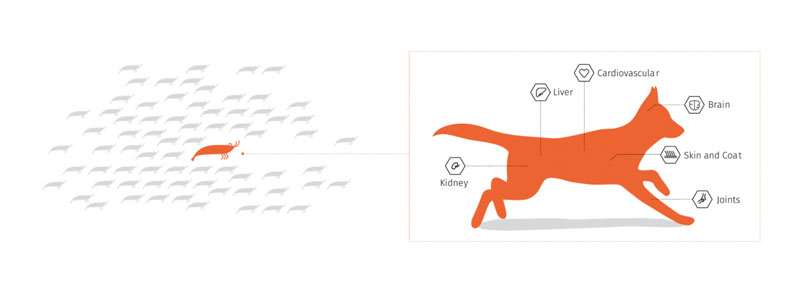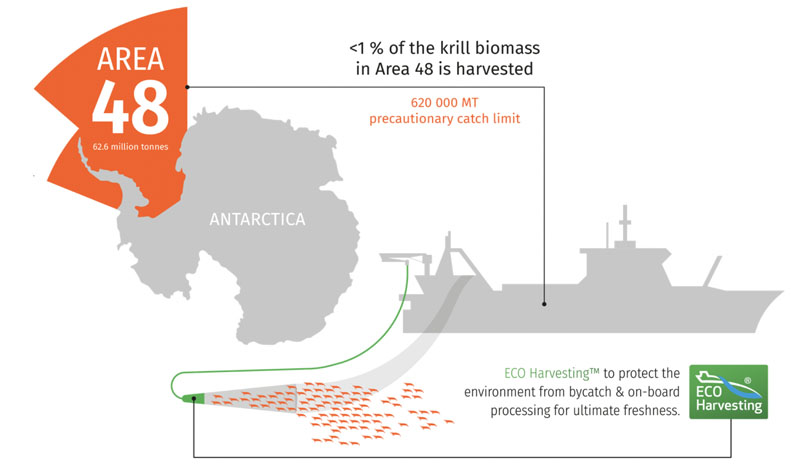More and more people are turning to products that support overall health and well-being these days, reports Ana Dumbravescu, Marketing Manager for QRILL Pet at Aker Biomarine.
It’s no secret that omega-3 fatty acids are among some of the most important nutrients to support long-term health and, according to a popular trend that seems to be locked in for the foreseeable future, “what’s good for me is also good for my pet.”
In fact, pet owners are increasingly concerned about preventive health and wellness and are seeking out healthy foods with proactive ingredients for their beloved furry family members.
Functional pet food ingredients that offer proven health benefits are becoming a focal point of major pet food brands. In addition, we foresee growth in pet food choices highlighting the inclusion of nutraceutical ingredients such as probiotics, omega-3 fatty acids, vitamins and more.
Including ingredients that are of high quality — or even those of human-grade level — will be a competitive advantage in this category.
Omega-3 fatty acids: wide-ranging pet health benefits
When it comes to food for pets, most of their nutritional needs are addressed through a variety of different ingredients; for example, every pet food formula contains fats, which, amongst others, should provide a balanced combination of the essential omega-6s and omega-3s.
Omega-3 fatty acids have wide-ranging positive effects for pet health and knowing the differences between various omega-3 sources and choosing the right one is important.

There are several available ingredients that can be added to food to provide pets with omega-3 fatty acids … and these sources are all delivered into their bodies in different ways.
For example, krill provides EPA and DHA (mainly in the form of phospholipids); and, as phospholipids are structurally different than omega-3 triglycerides (found in fish and algae), this difference dictates how EPA and DHA is metabolised.
Plant-based omega-3s in the form of ALA have to be converted to EPA and DHA to provide the same health benefits. However, the conversion rate of ALA to EPA and DHA is poor in pets; less that 10% is actually converted into these vital fatty acids. Hence, marine omega-3s are more effective that plant-based ones.
The health benefits of krill for pets
Not all omega-3 fatty acids are created equal and krill is a unique source. Similar to humans, Antarctic krill offers the same multiple benefits for pets (Figure 1).
In addition to its phospholipid advantage, krill is also naturally rich in marine proteins, choline and astaxanthin. Choline is essential for a healthy liver and important for brain and muscle health.
Another benefit is the antioxidant astaxanthin, which is known as a natural protectant. Just like vitamin E, it also helps to boost a pet’s immune system, but is actually 100 times more effective than vitamin E.

Figure 1: The pet health benefits of Antarctic krill
The phospholipid advantage
Most of the omega-3s in Antarctic krill are bound to phospholipids. Unlike triglycerides, phospholipids are water-soluble.
This distinctive feature of phospholipid omega-3s lets them move in a different way in the body than triglycerides and are therefore more effectively integrated into cell membranes. This process, known as the phospholipid advantage, allows the pet to benefit from these essential fatty acids in a more efficient way.
In fact, some refer to phospholipids as the “molecules of life.” Phospholipids are natural, integral parts of human and animal cells that help to maintain the strength, flexibility and integrity of cells and their membranes.
Recent studies have shown that the phospholipid-bound omega-3s from krill are more effective at raising omega-3 levels in a dog’s body compared with triglyceride-bound omega-3s, such as those found in fish oil.1
Phospholipid omega-3s are easy for a pet’s body to transport and incorporate into the cell membranes of tissues and vital organs where they are needed the most.
On the contrary, other sources of omega-3s in triglyceride form must be rebuilt into phospholipids before they can be taken up by the pet’s cells. The triglycerides are also more likely to be used as energy or fat storage, and vital omega-3s can therefore be lost instead of ending up in the cells where they affect health.
Clean label, sustainability and full transparency
There is no question that consumers want healthy food choices for their pets; at the same time, though, they want peace of mind in terms of environmental and ethical claims.
In support of the mindful choice movement, the clean label demand will require pet food brands to offer full transparency on their ingredient lists. As consumers are keen to know where their products come from, 100% traceability will be the preferred choice of producers to meet consumer demands.
Additionally, people take omega-3 supplements as part of their healthy lifestyle and it’s important for them to know that these supplements are coming from sustainable sources.
The health of the planet is as important as, and naturally linked to, the health of an individual … and there’s no question that the same thing can be said for pets!
Sourcing marine ingredients from a supplier that values sustainability has become very important for many pet brand owners.2 More than ever, consumers and businesses alike care about the health of our oceans.
Antarctic krill is considered to be one of the most environmental sources for marine omega-3s — but only if harvesting maintains the long-term sustainability of the Southern Ocean’s ecosystem and protects all Antarctic species.
The Antarctic Krill Fishery is managed and regulated by the Commission for the Conservation of Antarctic Marine Living Resources (CCAMLR). It only operates within a small area of the Southern Ocean, called Area 48 (Figure 2). Within this area, the CCAMLR has set a catch quota of 1% of the total biomass, which makes it one of the most precautionary in the world.

Figure 2: Sustainable sourcing is more important than ever before
You should also ensure that the krill ingredient you chose is certified by the Marine Stewardship Council (MSC). MSC certification guarantees that the marine resources are harvested using sustainable methods and that all the products are traceable throughout the supply chain.
These fisheries and manufacturers are audited by independent, third-party evaluators before they are MSC certified. This means our fishery meets the most stringent sustainability standards.
When it comes to krill, the MSC certification ensures that the ingredient’s entire supply chain can be traced back to the location it originates from. This way, you have the chance to be part of the entire journey of this unique ingredient.
A sustainable krill ingredient for optimal pet health
QRILL Pet, a brand of the biotech innovator and Antarctic krill-harvesting company, Aker BioMarine, focuses on keeping pets healthy and happy.
Made only from Antarctic krill, QRILL Pet delivers omega-3 fatty acids, marine proteins, choline and the antioxidant astaxanthin. This unique functional marine ingredient also carries the highest-ranking sustainability certificate (MSC) on the market.
References
- www.qrillpet.com/blog-and-news/new-study-reveals-krill-sourced-omega-3s-most-effective-in-alaskan-husky-diet.
- www.qrillpet.com/krill-is-sustainable.
